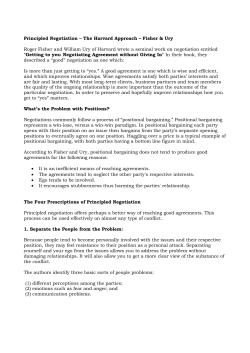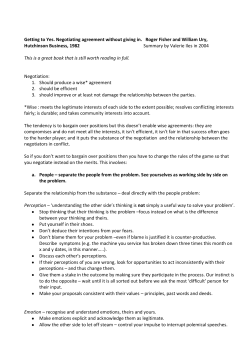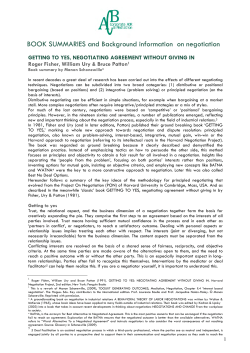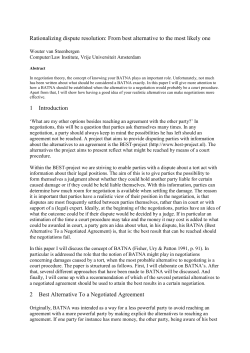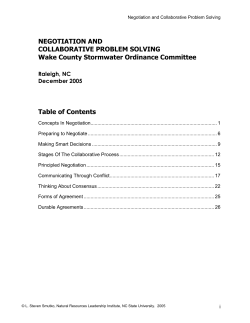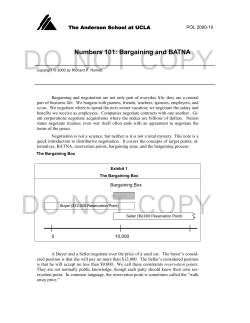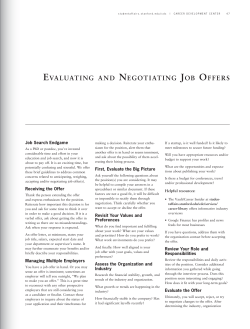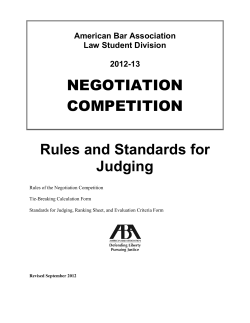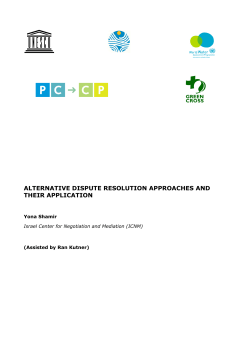
By Frumi Rachel Barr, MBA, Ph.D. Copyright year: 2 addition 1991
Getting to Yes Negotiating Agreement Without Giving In By Frumi Rachel Barr, MBA, Ph.D. Author: Roger Fisher & William Ury Publisher: The Penguin Group Copyright year: 2nd addition 1991 ISBN:0 14 01.5735 2 Authors’ bio and credits: The authors of this book are part of the Harvard negotiation project and have been working together since 1977. Author's main point Getting to Yes offers a concise, step-by-step proven strategy for coming to mutually acceptable agreements in every sort of conflict – whether it involves parents and children, neighbors, bosses and employees, customers or corporations, tenants or diplomats. INTRODUCTION Negotiation is a fact of life. Everyone negotiates something every day. Negotiation is a basic means of getting what you want from others. It is back and forth communication designed to reach an agreement when you and the other side have some interests that are shared and others that are opposed. Whether in business, government, or the family, people reach most decisions through negotiation. Standard strategies for negotiation often leave people dissatisfied, worn out, or alienated and frequently all three. The method of principled negotiation developed at the Harvard negotiation project is to decide issues on their merits rather than through a haggling process focused on what each side says it will and won’t do. It suggests that you look for mutual gains whenever possible, and that where your interests conflict, you should insist that the results be based on some fair standards independent of the will of either side. Principled negotiation shows you how to obtain what you are entitled to and still be decent. It enables you to be fair while protecting you against those who would take advantage of your fairness. Every negotiation is different, but the basic elements do not change. Principled negotiation can be used whether there is one issue or several; two parties or many; whether there is a prescribed ritual, as in collective bargaining, or an impromptu free for all as in talking with hijackers. Principled negotiation is an all purpose strategy. If the other side learns this one, it does not become more difficult to use; it becomes easier. ceoconfidante@frumi.com www.100mustreads.com 1 I. THE PROBLEM 1. DON'T BARGAIN OVER POSITIONS People routinely engage in positional bargaining. Each side takes a position, argues for it, and makes concessions to reach a compromise. Any method of negotiation may be fairly judged by three criteria: it should produce a wise agreement if agreement is possible. It should be efficient. And it should improve or at least not damage the relationship between the parties. Positional bargaining fails to meet the basic criteria of producing a wise agreement, efficiently and amicably. Arguing over positions produces unwise agreements When negotiators bargain over positions, they tend to lock themselves into those positions. The more you clarify your position and defend it against attack, the more committed you become to it. As more attention is paid to positions, less attention is devoted to meeting the underlying concerns of the parties. Agreement becomes less likely. Arguing over positions is inefficient Bargaining over positions creates incentives that stall settlement. The more extreme the opening positions and the smaller the concessions, the more time and effort it will take to discover whether or not agreement is possible. Dragging one’s feet, threatening to walk out, stonewalling, and other such tactics become commonplace. They all increase the time and cost of reaching agreement as well as the risk that no agreement will be a reached it all. Arguing over positions endangers an ongoing relationship Positional bargaining becomes a contest of will. Anger and resentment often result as one side sees itself bending to the rigid will of the other while its own legitimate concerns go unaddressed. When there are many parties, positional bargaining is even worse The more people involved in a negotiation, the more serious the drawbacks to positional bargaining. Being nice is no answer People recognize the high costs of hard positional bargaining, particularly on the parties and their relationship. They hope to avoid them by following a more gentle style of negotiation. Within families and among friends much negotiation takes place in this way. The process tends to be efficient, at least to the extent of producing results quickly. Any negotiation primarily concerned with the relationship runs the risk of producing a sloppy agreement. Pursuing a soft and frilly form of positional bargaining makes you vulnerable to someone who plays a hard game of positional bargaining. In positional bargaining, a hard game dominates a soft one. The process will produce an agreement, although it may not be a wise one. There is an alternative If you do not like the choice between hard and soft positional bargaining you can change the game. ceoconfidante@frumi.com www.100mustreads.com 2 The Harvard negotiation project developed an alternative to positional bargaining: a method of negotiation explicitly designed to produce wise outcomes efficiently and amicably. This method called principled negotiations is negotiation on the merits, and can be boiled down to four basic points. These four points define a straightforward method of negotiation that can be used under almost any circumstance. Each point deals with the basic element of negotiation, and suggests what you should do about it. o People: separate the people from the problem. o Interests: focus on interests, not positions. o Options: generate a variety of possibilities before deciding what to do. o Criteria: insist that the result be based on some objective standard. Some fair standards such as market value, expert opinion, custom, or law determine the outcome. The four propositions to principled negotiation are relevant from the time you begin to think about negotiating until the time either an agreement is reached or you decide to break off the effort. That period can be divided into three stages: analysis, planning, and discussion. o During the analysis stage you are simply trying to diagnose the situation-to gather information, organize it, and think about it. You’ll want to consider the people problems of partisan perceptions, hostile emotions, and unclear communication, as well as to identify your interests and those of the other side. You’ll want to note actions already on the table and identify any criteria already suggested as a basis for agreement options. o During the planning stage you deal with the same four elements a second time, both generating ideas and deciding what to do. o You’ll want to generate additional options and additional criteria for deciding among them. o Again during the discussion stage, when the parties communicate back and forth, looking for an agreement, the same four elements are the best subjects to discuss. Differences in perceptions, feelings of frustration and anger, and difficulties in communication can be acknowledged and addressed. Each side should come to understand the interests of the other. Both can then jointly generate options that are mutually advantageous and seek agreement on objective standards for resolving opposed interests. To sum up, in contrast to positional bargaining, the principled negotiation methods of focusing on basic interests, mutually satisfying options and fair standards typically results in a wise agreement. The method permits you to reach a gradual consensus on a joint decision efficiently without all the transactional costs of digging into positions only to give have to dig yourself out of them. And separating the people from the problem allows you to deal directly and empathetically with the other negotiator as a human being, thus making possible an amicable agreement. II. THE METHOD 2. SEPARATE THE PEOPLE FROM THE PROBLEM Negotiators are people first ceoconfidante@frumi.com www.100mustreads.com 3 A basic fact about negotiation, easy to forget in corporate and international transactions, is that you’re dealing not with abstract representatives of the other side, but with human beings. They have emotions, deeply held values, and different backgrounds and viewpoints; and they are unpredictable. A working relationship where trust, understanding, respect, and friendship are built up over time can make each new negotiation smoother and more efficient. On the other hand, people get angry, depressed, fearful, hostile, frustrated, and offended. They have egos that are easily threatened. They see the world from their own personal vantage point, and they frequently confuse their perceptions with reality. Failing to deal with others sensitively as human beings prone to human reactions can be disastrous for a negotiation. Every negotiator has two kinds of interests: in the substance and in the relationship Most negotiations take place in the context of an ongoing relationship where it is important to carry on each negotiation in a way that will help rather than hinder future relations and future negotiations. The relationship tends to become entangled with the problem On both the giving and receiving end, we’re likely to treat people and problem as wants. People draw from comments on substance unfounded inferences which they then treat as facts about that person’s intentions and attitudes toward them. Positional bargaining puts relationship and substance in conflict Positional bargaining deals with the negotiators interests both in substance and in a good relationship by trading off against the other. Giving in on a substantive point may buy no friendship; it may do nothing more than convince the other side they can be taken for a ride. Separate the relationship from the substance; deal directly with the people problem To find your way through the jungle of people problems, it is useful to think in terms of three basic categories: perception, emotion, and communication. Perception Whether you are making a deal or settling a dispute, differences are defined by the difference between your thinking and theirs. Ultimately, however, conflict lies not in objective reality, but in people’s heads. As useful as looking for objective reality can be, it is ultimately the reality as each side sees it that constitutes the problem in a negotiation and opens the way to a solution. Put yourself in their shoes How you see the world depends on where you sit. People tend to see what they want to see. They tend to pick out and focus on most facts that confirm their prior perceptions and to disregard or misinterpret those that call their perceptions into question. The ability to see the situation as the other sees it, as difficult as it may be, is one of the most important skills a negotiator can possess. Understanding their point of view is not the same as agreeing with it. Don't deduce their intentions from your fears It is all too easy to fall into the habit of putting the worst interpretation on what the other side says or does. The costs of interpreting whatever they say or do in its most dismal light is that ceoconfidante@frumi.com www.100mustreads.com 4 fresh ideas in the direction of agreement are spurned, and subtle changes of position are ignored and rejected. Don't blame them for your problem Blaming is an easy mode to fall into, but even if blaming is justified, it is usually counter productive. Discuss each other's perceptions One way to deal with differing perceptions is to make them explicit and discuss them with the other side. It is common in a negotiation to treat as “unimportant” those concerns of the other side perceived as not standing in a way of an agreement. Look for opportunities to act inconsistently with their perceptions Perhaps the best way to change the perceptions is to send a message different from what they expect. Give them a stake in the outcome by making sure they participate in the process If they’re not involved in the process they are hardly likely to approve the product. If you want the other side to accept a disagreeable conclusion, it is crucial that you involve them in the process of reaching that conclusion. Even if the terms of an agreement seem favorable, the other side may reject them simply out of suspicion born of their exclusion from the drafting process. Agreement becomes much easier if both parties feel ownership of the ideas. To involve the other side, get them involved early. Ask their advice. Giving credit generously for ideas wherever possible will give them a personal stake in defending those ideas to others. The feeling of participation in the process is perhaps the single most important factor in determining whether a negotiator accepts a proposal. In a sense the process is the product. Face-saving: Make your proposals consistent with their values Face saving reflects a person’s need to reconcile the stand he takes in a negotiation or an agreement with his principles and with his past words and deeds. Often in negotiation people will continue to hold out not because the proposal on the table is inherently unacceptable, but simply because they want to avoid the feeling of the appearance of backing down to the other side. Face saving involves reconciling an agreement with principle and with the self image or the negotiators. Emotion In a negotiation, particularly in a bitter dispute, feelings may be more important than talk. People often come into a negotiation realizing that the stakes are high and feeling threatened. Emotions may quickly bring a negotiation to an impasse or an end. First recognize and understand emotions, theirs and yours Ask yourself what is producing the emotions. Make emotions explicit and acknowledge them as legitimate Talk with the people of the other side about their emotions. Talk about your own. Making your feelings or theirs an explicit focus of discussion will not only underscore the seriousness of the problem, it will also make the negotiations less reactive and more proactive. Freed from the burden of expressed emotions, people will become more likely to work on the problem. ceoconfidante@frumi.com www.100mustreads.com 5 Allow the other side to let off steam Often one effective way to deal with people’s anger, frustration, and negative emotions is to help the release of those feelings. Hence, instead of interrupting polemical speeches or walking out on the other party, you may decide to control yourself, sit there, allow them to pour out their grievances at you. Perhaps the best strategy to adopt while the other side lets off steam is to listen quietly without responding to their attacks, and occasionally to ask the speaker to continue until he has spoken his last word. Don't react to emotional outbursts Use symbolic gestures Acts that would produce a constructive emotional impact on one side often involve little or no cost to the other. On many occasions an apology can defuse emotions effectively, even when you do not acknowledge personal responsibility for the action or admits an intention to harm. An apology may be one of the least costly and most rewarding investments you can make. Communication Without communication there is no negotiation. Negotiation is a process of communicating back and forth for the purpose of reaching a joint decision. There are three big problems in communication. First, negotiators may not be talking to each other, or at least not in such a way as to be understood. The second problem in communication is that people don’t seem to pay attention to what you say. In a negotiation, you may be so busy thinking about what you’re going to say next, how you’re going to respond to the last point or how you’re going to frame your next argument, that you forget to listen to what the other side is saying now. If you’re not hearing what the other side is saying, there is no communication. The third communication problem is misunderstanding. What one says, the other may misinterpret. Where the parties speak different languages the chance for misinterpretation is compounded. Listen actively and acknowledge what is being said Listening enables you to understand their perceptions, feel their emotions, and hear what they’re trying to say. It has been said that the cheapest concession you can make to the other side is to let them know they have been heard. Standard techniques of good listening are to pay close attention to what is said, to ask the party to spell out carefully and clearly exactly what they mean, and to request that ideas be repeated if there is an ambiguity or uncertainty. Take their perceptions, their needs, and their constraints. Unless you acknowledge what they’re saying and demonstrate that your understanding them, they may believe you have not heard them. As you repeat what you understood them to have said, phrase it positively from their point of view, making the strength of their case clear. Understanding is not agreeing. Unless you can convince them that you do grasp how they see it, you may be unable to explain your point of view to them. Speak to be understood Talk to the other side. Negotiation is not a debate. Nor is it a trial. ceoconfidante@frumi.com www.100mustreads.com 6 To reduce the dominating and distracting effect that the press, home audiences, and third parties may have, it is useful to establish private and confidential means of communicating with the other side. No matter how many people are involved in a negotiation, important decisions are typically made when no more than two people are in the room. Speak about yourself, not about them It is more persuasive, however, to describe a problem in terms of its impact on you than in terms of what they did or why. A statement about how you feel is difficult to challenge. You convey the same information without provoking a defensive reaction that will prevent them from taking it in. Speak for a purpose Sometimes the problem is not too little communication, but too much. When anger and misperceptions are high, some thoughts are best left unsaid. Before making a significant statement, know what you want to communicate or find out, and know what purpose this information will serve. Prevention works best The best time for handling people problems is before they become people problems. It also means structuring the negotiating game in ways that separate the substantial problem from the relationship and protect people’s egos from getting involved in substantive discussion. Build a working relationship Knowing the other side personally really does help. The more quickly you can turn a stranger into someone you know, the easier negotiation is likely to become. You have less difficulty understanding where they’re coming from. You have a foundation of trust to build upon in a difficult negotiation. The time to develop such a relationship is before the negotiation begins. Find ways to meet them informally. Face the problem, not the people A more effective way for the parties to think is of themselves as partners in a hardheaded, side by side search for a fair agreement advantageous to each. Separating the people from the problem is not something you can do once and forget about; you have to keep working at it. The basic approach is to deal with the people as human beings and with the problem on its merits. 3. FOCUS ON INTERESTS, NOT POSITIONS For a wise solution reconcile interests, not positions The difference between positions and interests is crucial. Interests define the problem The basic problem in a negotiation lies not in conflicting positions, but in the conflict between each side’s needs, desires, concerns, and fears. Such desires and concerns are interests. Interests motivate people; they are the silent movers behind the hubbub of position. Your position is something you have decided upon. Your interests are what caused you to so decide. ceoconfidante@frumi.com www.100mustreads.com 7 When you do look behind opposed positions for the motivating interests, you can often find an alternative position which meets not only your interests but theirs as well. Reconciling interests rather than compromising between positions also works because behind opposed positions lie many more interests than conflicting ones. Behind opposed positions lie shared and compatible interests, as well as conflicting ones Shared interests and differing but complimentary interests can both serve as the building blocks for wise agreement. How do you identify interests? A position is likely to be concrete and explicit; the interests underlying it may well be unexpressed, intangible, and perhaps inconsistent. How do you go about understanding the interests involved in a negotiation, remembering that figuring out their interests will be at least as important as figuring out yours? Ask "Why?" One basic technique is to put yourself in their shoes. Examine each position they take, and ask yourself “why?” Ask "Why not?" Think about their choice. If you’re trying to change their minds, the starting point is to figure out where their minds are now. In constructing the other side’s currently perceived choice the first question is to ask “whose decision do I want to affect?” The second decision is what decision people on the other side now see you asking them to make. If you have no idea about what they think they’re being called on to do, they may not either. Only rarely will you deal with the decision maker who writes down and weighs the pros and cons. Realize that each side has multiple interests A common error in diagnosing a negotiating situation is to assume that each person on the other side has the same interests. Thinking of negotiation as a two person, two sided affair can be illuminating, but it should not blind you to the usual presence of other persons, other sides, and other influences. Every negotiator has a constituency to whose interests he is sensitive. The most powerful interests are basic human needs If you can take care of such basic needs, you increase the chance both of reaching agreement and, if an agreement is reached, of the other side keeping to it. Basic human needs include: o Security o Economic well being o A sense of belonging o Recognition o Control over one’s life In many negotiations, we tend to think that the only interests involved are money. Yet even in a negotiation that is all for a monetary figure, such as the amount of alimony to be specified in a separation agreement, much more can be involved. What is true for individuals remain equally true for groups and nations. ceoconfidante@frumi.com www.100mustreads.com 8 Make a list. To sort out the various interests of each side, it helps to write them down as they occur to you. It may stimulate ideas for how to meet these interests. Talking about interests If you want the other side to take your interests into account, explain to them what those interests are. Make your interests come alive It is your job to have the other side understand exactly how important and legitimate your interests are. One guideline is to be specific. Concrete details not only make your description credible, they add impact. As long as you do not seem to imply that the other side’s interests are unimportant or illegitimate, you can afford to take a strong stance in setting forth the seriousness of your concerns. You need to convince them that they might well feel the same way if they were in your shoes. Acknowledge their interests as part of the problem. People listen better if they feel that you have understood them. They tend to think that those who understand them are intelligent and sympathetic people whose own opinions may be worth listening to. So if you want the other side to appreciate your interests, begin by demonstrating that you appreciate theirs. It helps to acknowledge that their interests are part of the overall problem you’re trying to solve. This is especially easy to do if your have shared interests. Put the problem before your answer If you want someone to listen and understand your reasoning, give your interests and reasoning first and your conclusions or proposals later. Look forward, not back We can choose to look back or to look forward. Few will satisfy your interest better if you talk about where you would like to go rather than about where you have come from. Instead of arguing with the other side about the past talk about what you want to have happen in the future. Be concrete but flexible To keep their flexibility, treat each option you formulate as simply illustrative. Think in terms of more than one option that meets your interests. Illustrative specificity is the key concept. Having thought about your interests, you should go into a meeting not only with one or more specific options that would meet your legitimate interest but also with an open mind. Be hard on the problem, soft on the people. It is usually advisable to be hard. It may not be wise to commit yourself to your position, but it is wise to commit yourself to your interests. This is the place in a negotiation to spend your aggressive energies. The other side, being concerned with their own interests, will tend to have overly optimistic expectations of the range of the possible agreements. Often the wisest solutions, those that produce the maximum gain for you at the minimum cost to the other side, are produced only by strongly advocating your interests. Two negotiators, each pushing hard ceoconfidante@frumi.com www.100mustreads.com 9 for their interests, will often stimulate each other’s creativity by thinking up a mutually advantageous solution. Attack the problem without blaming the people. Go even further and be personally supportive: listen to them with respect, show them courtesy, express your appreciation for their time and effort, emphasize your concern with meeting their basic needs, and so on. Show them that you’re attacking the problem, and not them. One useful rule of thumb is to give positive support to the human beings on the other side equal in strength to the vigor with which you emphasize the problem. This combination of support and attack may seem inconsistent. Psychologically, it is; the inconsistency helps make it work. The theory of cognitive dissonance, holds that people dislike inconsistency and will act to eliminate it. Negotiating hard for your interests does not mean being closed to the other side’s point of view. Successful negotiation requires being firm and open. 4. INVENT OPTIONS FOR MUTUAL GAIN The problem is a common one. There seems to be no way to split the pie that leaves both parties satisfied. One lawyer attributes his success directly to his ability to invent solutions advantageous to both his client and the other side. He expands the pie before dividing it. Skill at inventing options is one of the most useful assets a negotiator can have. Diagnosis As valuable as it is to have many options, people involved in a negotiation rarely sense a need for them. In most negotiations there are four major obstacles that inhibit the inventing of an abundance of options: (1) premature judgment; (2) searching for the single answer; (3) the assumption of a fixed pie; and (4) thinking that solving their problem is their problem. Premature judgment Inventing options does not come naturally. Nothing is so harmful to invent as a critical sense waiting to pounce on the drawbacks of any new idea. Judgment hinders imagination. Under the pressure of a forthcoming negotiation, your critical sense is likely to be sharper. Practical negotiation appears to call for practical thinking. Searching for the single answer People see their job as narrowing the gap between positions not broadening the options available. If the first impediment to creative thinking is premature criticism, the second is premature closure. By looking from the outset for the single best answer, you are likely to short circuit a wiser decision-making process in which you select from a larger number of possible answers. The assumption of a fixed pie Each side sees the situation as essentially either/or-either I get what is in dispute or you do. A negotiation often appears to be a “fixed sum” game. Thinking "solving their problem is their problem" ceoconfidante@frumi.com www.100mustreads.com 10 A final obstacle to inventing realistic options lies in each side’s concern with only its own immediate interests. For a negotiator to reach an agreement that meets his own self interests he needs to develop a solution which also appeals to the self interest of the other. There also frequently exists a psychological reluctance to accord anyone legitimacy to the views of the other side. Prescription To invent creative options, then, you will need (1) to separate the act of inventing options from the act of judging them; (2) to broaden the options on the table rather than look for a single answer; (3) to search for mutual gains; and (4) to invent ways of making their decisions easy. Separate inventing from deciding Since judgment hinders imagination, separate the creative act from a critical one; separate the process of thinking up possible decisions from the process of selecting among them. Invent first, decide later. By definition, inventing new ideas requires you to think about things that are not already in your mind. You should therefore consider the desirability of arranging a brainstorming session with a few colleagues and friends. Such a session can effectively separate inventing from deciding. The key ground rule is to postpone all criticism and evaluation of ideas. The group simply is inventing ideas without pausing to consider whether they’re good or bad, realistic or unrealistic. With those innovations removed, one idea should stimulate another. Before brainstorming 1. Define your purpose. 2. Choose a few participants 3. Change the environments 4. Design an informal atmosphere 5. Choose a facilitator During brainstorming 1. Seat the participants side by side facing the problem. The physical reinforces the psychological. 2. Clarify the ground rules, including the no criticism rule. The meeting begins with the introductions all around, followed by clarification of the ground rules. Wild ideas are encouraged, even those that in fact lie well outside the realm of the possible, the group may generate from those ideas other options that are possible and that no one would previously have considered. To take the entire session off the record and to refrain from attributing ideas to any participant. 3. Brainstorm 4. Record the ideas in full view. Gives the group a tangible sense of collective achievement; it reinforces the no criticism rule; it reduces the tendency to repeat; and it helps stimulate other’s ideas. After brainstorming 1. Star the most promising ideas. 2. Invent improvements for promising ideas. 3. Setup the time to evaluate ideas and decide. Consider brainstorming with the other side ceoconfidante@frumi.com www.100mustreads.com 11 Although more difficult than brainstorming with your own side, brain storming with people from the other side can also prove extremely valuable. It is more difficult because of the increased risk that you will say some things that prejudice your interests despite the rules established for brainstorming sessions. To protect yourself when brainstorming with the other side, distinguish the brainstorming session explicitly from a negotiating session where people state official views and speak off the record. People are so accustomed to meeting for the purpose of reaching agreement that any other purpose needs to be clearly stated. To reduce the risk of appearing committed to any given idea, you can make a habit of advancing at least two alternatives at the same time. You can also put on the table options with which you obviously disagree. Time spent brainstorming together is surely among the best spent time in negotiation. Broaden your options The key to wise decision making, lies in selecting from a great number and variety of options. Multiply options by shuttling between the specific and the general: The Circle Chart The task of inventing options involves four types of thinking. One is thinking about a particular problem-the factual situation you dislike, for example a smelly polluted river that runs by your land. The second type of thinking is descriptive analysis-you diagnose an existing situation in general terms. You sort problems into categories and tentatively suggest causes. The third type of thinking, again in general terms, is to consider what ought, perhaps, to be done. The fourth and final type of thinking is to come up with some specific and feasible suggestions for action. Who might do what tomorrow to put one of those general approaches into practice? Look through the eyes of different experts Another way to generate multiple options is to examine your problem from the perspective of different professionals and disciplines. Consider in turn how each expert would diagnose the situation, what kinds of approaches each might suggest, and what practical suggestions would follow from those approaches. Invent agreements of different strengths You can multiply the number of possible agreements on the table by thinking of weaker versions you might want to have on hand in case sought for agreement proves beyond reach. At the very least, if you or the other side cannot reach first order agreement, you can usually reach second order treatment. Change the scope of a proposed agreement You could, for instance, fractionate your problem into smaller and perhaps more manageable units. Agreements may be partial, involve fewer parties, cover only selected subject matters, apply only to a certain geographical area, or remain in effect for only a limited period of time. Look for mutual gain The third major block to creative problem solving lies in the assumption of a fixed pie: the less for you, the more for me. There are almost always exists the possibility of joint gain. Identify shared interests ceoconfidante@frumi.com www.100mustreads.com 12 As a negotiator, you will almost always want to look for solutions that will leave the other side satisfied as well. In almost every case, your satisfaction depends to a degree on making the other side sufficiently content with any agreement to want to live up to it. Three points about shared interests are worth remembering. First, shared interests lie latent in every negotiation. Second, shared interests are opportunities. To be of use, you need to make something out of them. It helps to make a shared interest explicit and to formulate it as a shared goal. Make it concrete and future oriented. Third, stressing your shared interests can make the negotiation smoother and more amicable. Dovetail differing interests A satisfactory agreement is made possible because each side wants different things. People generally assume that differences between two parties create the problem. Yet differences can also lead to a solution. The kinds of differences that best lend themselves to dovetailing are differences in interests, and beliefs, in the value placed on time, in forecasts, and in aversion to risk. Ask for their preferences One way to dovetail interests is to invent several options all equally acceptable to you and ask the other side which one they prefer. You can then take that option, work with it some more, and again present two or more variants, asking which one they prefer. If dovetailing had to be summed up in one sentence, it would be: look for items that are of low cost to you and high benefit to them and vice versa. Make their decision easy Since success for you in a negotiation depends upon the other side making this a decision you want, you should do what you can to make that decision an easy one. Confront them with a choice that is as painless as possible. Whose shoes? However complex the other side’s decisional process may seem, you will understand it better if you pick one person-probably the person with whom you’re dealing-and see how the problem looks from his or her point of view. If you place yourself firmly in the shoes of your opposite number, you’ll understand his problem and what kind of options might solve it. What decision? Your task is to give them not a problem but an answer, to give them not a tough decision but an easy one. It is crucial in that process to focus your attention on the content of the decision itself. Few things facilitate a decision as much as precedent. This provides an objective standard for your request and makes it easier for them to go along. Making threats is not enough. We often try to influence others by threats and warnings of what will happen if they do not decide as we would like. Offers are usually more effective. Concentrate both on making them aware of the consequences they can expect if they do decide as you wish and on improving those consequences from their point of view. To evaluate an option from the others side’s point of view, consider how they might be criticized if they adopted it. In a complex situation, creative inventing is an absolute necessity. In any negotiation it may open doors and produce a range of potential agreements satisfactory to each side. Therefore, ceoconfidante@frumi.com www.100mustreads.com 13 generate many options before selecting among them. Invent first; decide later. Look for shared interests and differing interests to dovetail. And seek to make the decision easy. 5. INSIST ON USING OBJECTIVE CRITERIA Deciding on the basis of will is costly Positional bargaining, trying to reconcile differences on the basis of will has serious costs. No negotiation is likely to be efficient or amicable if you pit your will against theirs, and either you have to back down or they do. You’re unlikely to reach a wise agreement as judged by any objective standard if you take no such standard into account. If trying to settle differences of interest on the basis of will has such high costs, the solution is to negotiate on some basis independent of the will of either side-that is, on the basis of objective criteria. The case for using objective criteria The approach is to commit yourself to reaching a solution based on principle, not pressure. Concentrate on the merits of the problem, not the mettle of the parties. Be open to reason, but closed to threats. Principled negotiation produces wise agreements amicably and efficiently The more you bring standards of fairness, efficiency, or scientific merit to bear on your particular problem, the more likely you are to produce a final package that is wise and fair. The more you and the other side refer to precedent and community practice, the greater your chance of benefiting from past experience. And an agreement consistent with precedent is less vulnerable to attack. A constant battle for dominance threatens a relationship; principled negotiation protects it. It is far easier to deal with people when both of you are discussing objective standards for settling a problem instead of trying to force each other to back down. People using objective criteria tend to use time more efficiently talking about possible standards and solutions. Independent standards are even more important to efficiency when more parties are involved. Developing objective criteria Carrying on a principled negotiation involves two questions: how do you develop objective criteria, and how to use them in negotiating? Whatever method of negotiation you use, you’ll do better if you prepare in advance. This certainly holds true of principled negotiations. So develop some alternative standards beforehand and think through their application to your case. Fair standards You’ll usually find more than one objective criteria available as a basis for agreement. Ideally, to assure a wise agreement, objective criteria should be not only independent of will but also both legitimate and practical. Use the test of reciprocal application to tell you whether a proposed criterion is fair and independent of either party’s will. Fair procedures ceoconfidante@frumi.com www.100mustreads.com 14 To produce an outcome independent of will, you can use either fair standards for the substantive question or fair procedures for resolving the conflicting interests. A variation on the procedure of “one cuts, the other chooses” is for the parties to negotiate what they think is a fair arrangement before they go on to decide their respective roles in it. As you consider procedural solutions, look at other basic means of settling differences: taking turns, drawing lots, letting someone else decide, and so on. The results may be unequal, but each side had an equal opportunity. Negotiating with objective criteria There are three basic points to remember: 1. Frame each issue as a joint search for objective criteria 2. Reason and be open to reason as to which standards are most appropriate to how they should be applied. 3. Never yield to pressure, only to principle. Frame each issue as a joint search for objective criteria If you’re negotiating to buy a house, you might start off by saying: look, you want a high price and I want a low one. Let’s figure out what a fair price would be. What objective standards might be most relevant? Ask "What's your theory?" Treat the problem as though the seller too is looking for a fair price based on objective criteria. Agree first on principles Your case will have more impact if it is presented in terms of their criteria, and they will find it difficult to resist applying their criteria to the problem. If they suggested the standard, their deferring to it is not an act of weakness but an act of strength, of carrying out their word. Reason and be open to reason What makes the negotiation a joint search is that, however much you may have purveyed and prepared various objective criteria, you come to the table with an open mind. You should be willing to respond to reasons for applying another standard or for applying a standard differently. If, however, after a thorough discussion of the merits of an issue you still cannot accept their proposed criteria as the most appropriate, you might suggest putting them to a test. Agree on someone you both regard as fair and give him or her a list of the proposed criteria. Ask the person to decide which are the fairest or most appropriate for your situation. A principled negotiator is open to reasoned persuasion on the merits; a positional bargainer is not. It is the combination of openness to reason with insistence on a solution based on objective criteria that makes principled negotiations so persuasive and so effective at getting the other side to play. Never yield to pressure Pressure can take many forms: a bribe, a threat, a manipulative appeal to trust, or a simple refusal to budge. In all these cases, the principled response is the same: invite them to state their reasoning, suggest objective criteria you think apply, and refuse to budge except on this basis. Never yield to pressure, only to principle. ceoconfidante@frumi.com www.100mustreads.com 15 In addition to your willpower, you also have the power of legitimacy and the persuasiveness of remaining open to reason. It will be easier for you to resist making an arbitrary concession than it will be for them to resist advancing some objective standards. A refusal to yield except in response to sound reasons is an easier position to defend-publicly and privately-than as a refusal to yield combined with a refusal to advance sound reasons. At the least, you’ll usually prevail on the question of process; you can usually shift the process from positional bargaining to a search for objective criteria. In this sense principled negotiation is a dominant strategy over positional bargaining. If there is no give in their position and you find no principled basis for accepting it, you should assess what you might gain by accepting their unjustified position rather than going to your best alternative. You should weigh the substantive benefit against the benefit to your reputation as a principled negotiator that could come from walking away. 111 YES, BUT . . . 6. WHAT IF THEY ARE MORE POWERFUL? (DEVELOP YOUR BATNA-BEST ALTERNATIVE TO A NEGOTIATED AGREEMENT) No method can guarantee success if all the leverage lies on the other side. In any negotiation there exist realities that are hard to change. In response to power, the most any method of negotiation can do is to meet two objectives: first, to protect you against making an agreement you should reject and second, to help you make the most of the assets you do have so that any agreement you reach will satisfy your interests as well as possible. Protecting yourself Under these conditions, a major danger is that you’ll be too accommodating to the views of the other side. You may end up with the deal you should have rejected. The costs of using a bottom line Negotiators commonly try to protect themselves against such an outcome by establishing in advance the worst acceptable outcome-their “bottom line”. Having a bottom line makes it easier to resist pressure and temptations of the moment. If there is more than one person on your side, jointly adopting the bottom line helps ensure that no one will indicate to the other side that you might settle for less. But the protection afforded by adopting the bottom line involves high costs. It limits your ability to benefit from what you learn during a negotiation. A bottom line also inhibits imagination. A bottom line-by its very nature rigid-is almost certain to be too rigid. A bottom line is likely to be set too high. Under other circumstances the bottom line may be too low. In short, while adopting a bottom line may protect you from accepting a very bad agreement, it may keep you both from inventing and from agreeing to a solution it would be wise to accept. Know your BATNA What is your BATNA-your Best Alternative To a Negotiated Agreement? That is the standard against which any proposed agreement should be measured. That is the only standard which can protect you both from accepting terms that are too unfavorable and for rejecting terms it would be in your best interest to accept. ceoconfidante@frumi.com www.100mustreads.com 16 Instead of ruling out any solution which does not meet your bottom line, you can compare a proposal with your BATNA to see whether it better satisfies your interests. The insecurity of an unknown BATNA If you have not thought carefully about what you’ll do if you fail to reach an agreement, you’re negotiating with your eyes closed. In most circumstances, the greater danger is that you’re too committed to reaching agreement. Not having developed any alternative to a negotiated solution, you’re unduly pessimistic about what would happen if negotiations broke off. As valuable as knowing your BATNA may be, you may hesitate to explore alternatives. You may avoid facing the question of what you’ll do if no agreement is reached. Having at least a tentative answer to the question is absolutely essential if you are to conduct negotiations wisely. Formulate a trip wire It is useful to identify one far from perfect agreement that is better than your BATNA. Tripwire package -A tripwire should provide you with some margin in reserve. Making the most of your assets The better your BATNA, the greater your power. People think of negotiating power as being determined by resources like wealth, political connections, physical strength, friends, and military might. In fact, the relative negotiating power of two parties depends primarily upon how attractive to each is the option of not reaching agreement. Develop your BATNA Generating possible BATNA requires three distinct operations: 1. Inventing a list of actions you might conceivably take if no agreement is reached 2. Improving some of the more promising ideas and converting them into practical alternatives 3. Selecting, tentatively, the one alternative that seems fast. Having gone through this effort, you now have a BATNA. Judge every offer against it. The better your BATNA, the greater your ability to improve the terms of any negotiated agreement. Knowing what you’re going to do if the negotiation does not lead to agreement will give you additional confidence in the negotiating process. It is easier to break off negotiations if you know where you’re going. The greater your willingness to break off negotiations, the more forcefully you can present your interests and the basis on which you believe an agreement should be reached. The desirability of disclosing your BATNA to the other side depends upon your assessment of the other side’s thinking. If your BATNA is extremely attractive, it is in your interest to let the other side know. If your best alternative to a negotiated agreement is worse for you than they think, disclosing it will weaken rather than strengthen your hand. Consider the other side's BATNA The more you can learn of their alternatives, the better prepared you are for negotiation. Knowing their alternatives, you can realistically estimate what you can expect from the negotiation. If they appear to overestimate their BATNA, you’ll want to lower their expectations. If both sides have attractive BATNA’s, the best outcome of the negotiation-for both parties-may well not be to reach agreement. In such cases a successful negotiation is one in which you and ceoconfidante@frumi.com www.100mustreads.com 17 they amicably and efficiently discovered that the best way to advance to respect and interest is for each of you to look elsewhere and not to try further to reach agreements. When the other side is powerful The stronger they appear in terms of physical and economic power, the more you benefit by negotiating on the merits. Apply knowledge, time, money, people, connections, and wits into devising the best solution for you independent of the other side’s assent. Developing your BATNA thus not only enables you to determine what is a minimally acceptable agreement, it will probably raise that minimum. Developing your BATNA is perhaps the most effective course of action you can take in dealing with a seemingly more powerful negotiator. 7. WHAT IF THEY WON'T PLAY? (USE NEGOTIATION JUJITSU) You may attack the problem on its merits; they may attack you. There are three basic approaches for focusing their attention on the merits. The first centers on what you can do. You yourself can concentrate on the merits, rather than on positions. You can change the game simply by starting to play a new one. If this doesn’t work and they continue to use positional bargaining, you can resort to a second strategy which focuses on what they may do. This counters the basic moves of positional bargaining and ways to direct their attention to the merits. The strategy we call negotiation jujitsu. The third approach focuses on what a third party can do. Negotiation jujitsu If they push you hard, you will tend to push back. Do not push back. Break the vicious cycle by refusing to react. Use your skill to step aside and turn their strength to your ends. Typically their “attack” will consist of three maneuvers: asserting their position forcefully, attacking your ideas, and attacking you. Don't attack their position, look behind it When the other side sets forth their position, neither reject it nor accept it. Treat it as one possible option. Look for the interest behind it, seek out the principles which it reflects, and think about ways to improve it. Assume every position they take is a genuine attempt to address the basic concerns of each side; ask them how they think it addresses the problem at hand. Treat their position as one option and objectively examine the extent to which it meets the interests of each party, or might be improved to do so. Seek out and discuss the principles underlying the other side’s positions. To direct their attention toward improving the options on the table discuss with them hypothetically what would happen if one of their positions was accepted. Don't defend your ideas, invite criticism and advice Instead of asking them to accept or reject an idea, ask them what’s wrong with it. Examine their negative judgments to find out their underlying interests and improve your ideas from their point of view. Rework your ideas in light of what you can learn from them, thus turn ceoconfidante@frumi.com www.100mustreads.com 18 criticism from an obstacle in the process of working toward agreement into an essential ingredient of that process. If another way to channel criticism in a constructive direction is to turn the situation around and ask for their advice. Ask them what they would do if they were in your position. Thus you lead them to confront your half of the problem. Recast an attack on you as an attack on the' problem’ Sit back and allow them to let off steam. Listen to them, show you understand what they’re saying, and when they have finished, recast their attack on you as an attack on the problem. Ask questions and pause Those engaged in negotiation jujitsu use two key tools. The first is to use questions instead of statements. Questions do not criticize, they educate. Silence is one of your best weapons. People tend to feel uncomfortable with silence, particularly if they have doubts about the merits of something they have said. Some of the most effective negotiating you will ever do is when you are not talking. Consider the one-text procedure You’ll probably call in third party only if your own efforts to shift the game from positional bargaining to principled negotiation have failed. More easily than one of those directly involved, a mediator can separate the people from the problem and direct the discussion to interests and options. A third party can also separate inventing from decision-making, reduce the number of decisions required to reach agreement, and help the parties know what they will get when they do decide. One process designed to enable third party to do all this is known as the one text procedure. The one text procedure not only shifts the game away from positional bargaining, it greatly simplifies the process both of inventing options and of deciding jointly on one. Prepare a draft to which no one has committed, ask for criticism, and improve the draft again and again until the mediator feels they could improve it no further. The one text procedure is a great help for two party negotiations involving a mediator. Almost essential for large multi lateral negotiations. You do not have to give anyone’s consent to start using the one text procedure. Simply prepare a draft and ask for criticism. Again you can change the game simply by starting to play the new one. If the other side is not willing to talk to you directly, a third party can take a draft around. Getting them to play Each exchange is headed by a stock phrase that a principled negotiator might use in any somewhat similar situation. "Please correct me if I'm wrong”. Making yourself open to correction and persuasion is a pillar in the strategy of principled negotiation. You can convince the other side to be open to the principles and objective facts you suggest only if you show yourself open to the ones they suggest. "We appreciate what you've done for us”. Giving personal support to the person on the other side is crucial to separating the people from the problem-separating relationship issues from the substantive merits. Praise and support, moreover, imply that the person will continue to deserve them. ceoconfidante@frumi.com www.100mustreads.com 19 "Our concern is fairness" "We would like to settle this on the basis of independent standards, not of who can do what to whom" "Trust is a separate issue”. It helps to have stock phrases like it’s not a question of trust to turn aside ploys for trust. "Could I ask you a few questions to see whether my facts are right?" Statements of fact can be threatening. Whenever you can, ask a question instead. "What's the principle behind your action?" A principled negotiator neither accepts nor rejects the other sides positions. He assumes there are good reasons. "Let me see if I understand what you are saying”. Restates in positive terms what he has heard to make sure he has indeed understood. Establishes a corporate if game in which both are making sure he understands the facts. "Let me get back to you" A good negotiator rarely makes an important decision on the spot. A little time and distance help separate the people from the problem. A good negotiator comes to the table with a credible reason in his pocket for leaving when he wants. "Let me show you where I have trouble following some of your reasoning" In principled negotiation you should preserve all your reasons first before offering a proposal. "One fair solution might be. . . ." Presents a proposal as a fair option which deserves joint consideration. Is the only fair solution, but one fair solution. "If we agree If we disagree... ." Bases the alternative on objective of principle by attributing it to a legal authority. Distances himself personally from the suggestion. “We'd be happy to see if we can leave when it's most convenient for you" "It's been a pleasure dealing with you" 8. WHAT IF THEY USE DIRTY TRICKS? (TAMING THE HARD BARGAINER) There are many tactics and tricks people can use to try to take advantage of you. Everyone knows some of them. If they recognize that a tricky bargaining tactic is being used against them, most people respond in one of two ways. The first standard responses to put up with it. Most people respond this way. The second common response is to respond in kind. Tricky bargaining tactics are in effect one sided proposals about negotiating procedure. To counter them, you’ll want to engage in principled negotiation about the negotiating process. How do you negotiate about the rules of the game? There are three steps in negotiating the rules of the negotiating game where the other side seems to be using a tricky tactic: recognize the tactic, raise the issue explicitly, and question the tactic’s legitimacy and a desirability-negotiate over it. Simply raising a question about a tactic may be enough to get them to stop using it. The most important purpose of bringing the tactic up explicitly, however is to give you an opportunity to negotiate about the rules of the game. This is the third step. This negotiation focuses on procedure instead of substance, but the goal remains to produce wise agreement (this time about procedure) efficiently and amicably. Not surprisingly, the method remains the same. ceoconfidante@frumi.com www.100mustreads.com 20 Separate the people from the problem Question the tactic, not their personal integrity. Don’t be diverted from the negotiation by the urge to teach them a lesson. Focus on interests, not positions Invent options for mutual gain Insist on objective criteria Frame the principle behind each tactic as a proposed rule for the game “shall we alternate spilling coffee on one another day by day?” Some common tricky tactics Tricky tactics can be divided into three categories: deliberate deception, psychological warfare, and positional pressure tactics. You should be prepared to deal with all three. Deliberate deception o Phony facts - The oldest form of negotiating trickery is to make some knowingly false statement. Making the negotiation proceed independent of trust. A practice of verifying factual assertions reduces the incentive for deception, and your risk of being cheated. o Ambiguous authority Do not assume that the other side has full authority just because there they are negotiating with you. If they do announce unexpectedly that they are treating what you thought was an agreement as a basis for further negotiation, insist on reciprocity. o Dubious intentions; Where the issue is one of possible misinterpretation of their intention to comply with the agreement, it is often possible to build compliance features into the agreement itself. o Less than full disclosure .Deliberate deception as to facts or one’s intentions is quite different from fully disclosing one’s present thinking. Good faith negotiation does not require total disclosure. We could disclose our thinking to some trustworthy third party, who can tell us whether there is a zone of potential agreement. Psychological warfare -These tactics are designed to make you feel uncomfortable, so that you’ll have a subconscious desire to end the negotiation as soon as possible. o Stressful situations Much has been written about the physical circumstances in which negotiations take place. Contrary to the accepted wisdom, it is sometimes advantageous to accept an offer to meet on the other side’s turf. It may put them at ease, making them more open to suggestions. If necessary, it’ll be easier for you to walk out. Ask yourself if you feel under stress. Be aware that the setting might have been deliberately designed to make you want to conclude negotiations promptly. Do not hesitate to say so. You can suggest changing chairs, taking a break, or adjourning into a different location or another time. In every case your job is to identify the problem, be willing to raise it with the other side, and then negotiate better physical circumstances in an objective and principled fashion. o Personal attacks - In addition to manipulating the physical environment, there are also ways for the other side to use verbal and nonverbal communication to make you feel uncomfortable. In each case recognizing the tactic will help nullify its effect; bringing up explicitly will probably prevent a recurrence. ceoconfidante@frumi.com www.100mustreads.com 21 o The good-guy/bad-guy routine -. The good guy bad guy routine is a form of psychological manipulation. If you recognize it, you won’t be taken in. o Threats. Threats are one of the most abused tactics in negotiation. Threats can lead to counter threats in an escalating spiral that can unhinge a negotiation and even destroy a relationship. Threats are pressure. Instead of making a decision easier for the other side, it often makes it more difficult. Good negotiators rarely resort to threats. Warnings are much more legitimate than threats and are not vulnerable to counter threats. For threats to be effective it must be credibly communicated. Positional pressure tactics - This kind of bargaining tactic is designed to structure the situation so that only one side can effectively make concessions. o Refusal to negotiate. First, recognize the tactic as a possible negotiating ploy: an attempt to use their entry into negotiation as a bargaining chip to obtain some concession on substance. A variant on this ploy is to set preconditions for negotiations. Second, talk about the refusal to negotiate. Find out their interests in not negotiating. Suggest some options, such as negotiating through third parties, sending letters, or encouraging private individuals like journalists to discuss the issues. Finally, insist on using principles. o Extreme demands Making an extreme demand that both you and they know will be abandoned undermines the credibility. Bringing the tactic to their attention works well here. Ask for principled justification of their propositions until it looks ridiculous even to them. o Lock-in tactics - The negotiator may raise one of his demands for every concession he makes on another. You may also reopen issues you thought had been settled. The benefits of this tactic lie in decreasing the overall concession, and in the psychological effect of making you want to agree quickly before he raises any more of his demands. An extreme commitment tactic designed to make it impossible to yield. Paradoxically, you strengthen your bargaining position by weakening your control over the situation. In labor management and international negotiations this tactic is common. But lock in tactics are gambles. Like threats, lock-in tactics depend on communication. Avoid making the commitment a central question. Deemphasize it so that the other side can more gracefully back down. o Hardhearted partner - Perhaps the most common negotiating tactics used to justify not yielding to your request is for the other negotiator to say that he personally would have no objection but his hardhearted partner will not let him. Recognize the tactics. Rather than discussing it with the other negotiator, you may want to get his agreement to the principle involved-perhaps in writing-and then if possible speak directly with the hardhearted partner. o A calculated delay - frequently one side will try to postpone coming to a decision until a time they think favorable. Waiting for the right time as the high cost game. o "Take it or leave it" There’s nothing inherently wrong with confronting the other side with a firm choice. This is an efficient method of conducting business, but it is not negotiation. Consider ignoring it at first. Keep talking as if you didn’t hear it, or change the subject, perhaps by introducing other solutions. Let them know what they have to ceoconfidante@frumi.com www.100mustreads.com 22 lose if no agreement is reached and look for a face saving way, such as a change in circumstances for them to get out of the situation. Don't be a victim You must decide on your own whether you want to use tactics you would consider improper and in bad faith if used against you. Whatever you do, be prepared to fight dirty bargaining tactics. It is easier to defend principle than an illegitimate tactic. Don’t be a victim. Reviewer's recommendation: A must read for the business community and individuals going through conflict. Get 100 business book summaries just like this one at 100mustreads.com Contact Frumi at 949-729-1577 ceoconfidante@frumi.com www.frumi.com www.100mustreads.com About the reviewer: Frumi Rachel Barr, MBA, PhD Many CEO's find themselves asking “What now?” to sensitive situations that only an experienced former CEO can understand. Frumi is brought in to solve problems and often remains to work with you, as your confidante and secret weapon. She has an uncanny knack of getting to the heart of your corporate climate and maximizing your team’s performance, profitability and sustainability. To schedule a free Break From the Pack to Success consultation email ceocondfidante@frumi.com or call 949-729-1577 ceoconfidante@frumi.com www.100mustreads.com 23
© Copyright 2025
